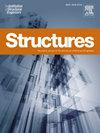Experimental and numerical research on hysteretic behavior of bolted end-plate connections
IF 3.9
2区 工程技术
Q1 ENGINEERING, CIVIL
引用次数: 0
Abstract
To investigate the seismic performance of end-plate connection, two scaled-down specimens, Z1 and Z2, were designed and tested under cyclic loading. These tests examined failure modes, load-bearing capacity, stiffness, ductility, and energy dissipation. The Z1 specimen failed due to shear in the column web, while Z2 developed a plastic hinge at the beam's end, showing different failure modes. The seismic performance of these joints was excellent, exceeding current standards and offering high safety reserves. A parametric analysis using 20 finite element simulations assessed key factors affecting joint performance. Results showed that while the axial compression ratio minimally affects initial stiffness, higher ratios may cause earlier failures at ultimate strength, recommending a maximum ratio of 0.5. The thickness of end-plate stiffeners, bolt diameter, and bolt pre-tension significantly influent both initial rotational stiffness and ultimate capacity, with column stiffener thickness mainly affecting initial stiffness. A design formula for initial rotational stiffness, based on the European Standard EC-3 component method, was validated by finite element model results, confirming its accuracy.
求助全文
约1分钟内获得全文
求助全文
来源期刊

Structures
Engineering-Architecture
CiteScore
5.70
自引率
17.10%
发文量
1187
期刊介绍:
Structures aims to publish internationally-leading research across the full breadth of structural engineering. Papers for Structures are particularly welcome in which high-quality research will benefit from wide readership of academics and practitioners such that not only high citation rates but also tangible industrial-related pathways to impact are achieved.
 求助内容:
求助内容: 应助结果提醒方式:
应助结果提醒方式:


